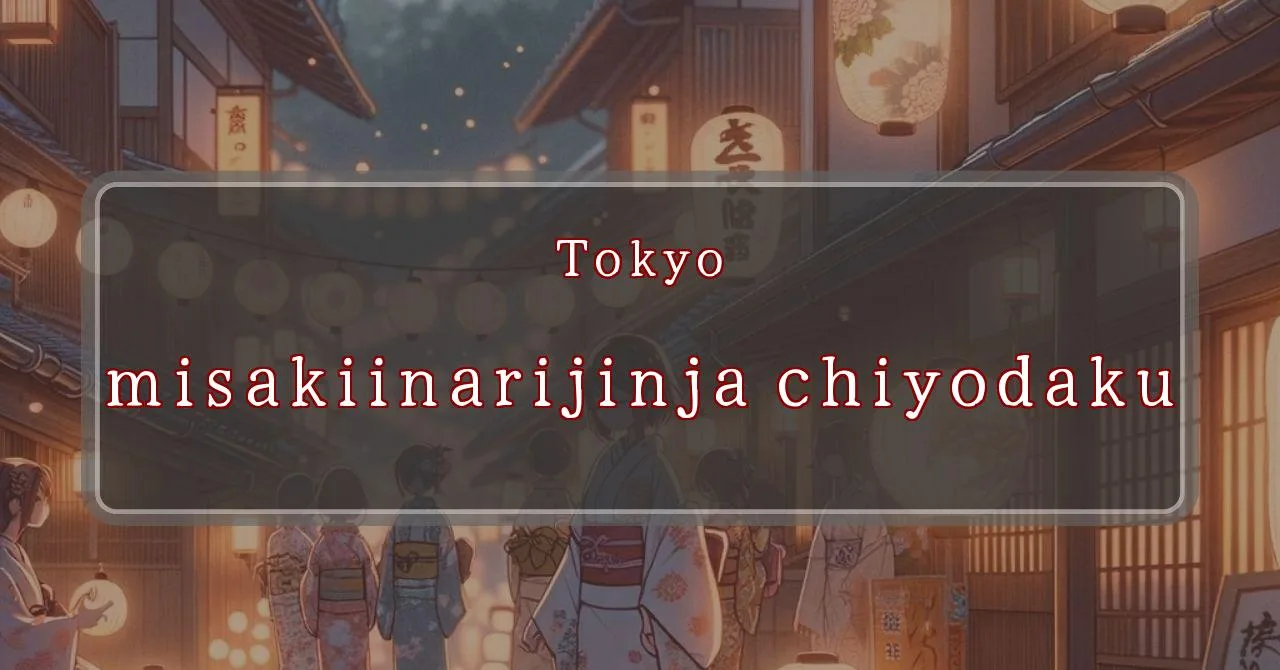Enchanting Shrine Festival in Tokyo
Basic Information
Here’s a detailed overview of the 2024 Misaki Inari Shrine Chiyoda Ward Festival.
- Address: 2-9-12 Misakicho, Chiyoda-ku, Tokyo
- Phone Number: 03-3261-1849
- Access: A 2-minute walk from the east exit of Suidobashi Station
- Festival Days: May 4th (Sat) and May 5th (Sun), 2024
Main Events and Attractions of the Festival
The Misaki Inari Shrine Chiyoda Ward Festival is a vibrant and colorful event that attracts many visitors each year. Here are some of the main events and attractions of the festival:
Mikoshi Procession
One of the highlights of the festival is the mikoshi procession. On May 4th, nine mikoshi (portable shrines) from various local communities gather at the Misaki Inari Shrine. The mikoshi are then carried through the streets of Chiyoda Ward, accompanied by music and dancing. The procession is a lively and festive event that draws large crowds of spectators.
Kagura Performance
Another popular attraction of the festival is the kagura performance. Kagura is a traditional Japanese dance and music performance that is often performed at Shinto shrines. The kagura performance at the Misaki Inari Shrine is a beautiful and graceful display of Japanese culture.
Food Stalls
No Japanese festival is complete without food stalls! At the Misaki Inari Shrine Chiyoda Ward Festival, there will be a variety of food stalls selling a wide range of delicious Japanese dishes. From classic festival favorites like yakitori and takoyaki to more unique dishes like inari sushi and kushikatsu, there’s something for everyone to enjoy.
Games and Activities
In addition to the mikoshi procession, kagura performance, and food stalls, there will also be a variety of games and activities for visitors of all ages to enjoy. These include traditional Japanese games like ring toss and goldfish scooping, as well as more modern games like face painting and balloon art.
Blessings and Deities
Misaki Inari Shrine is dedicated to four deities: Ukanomitama no Kami, Susanoo no Mikoto, Ohoimi no Kami, and Omononushi no Kami. These deities are associated with various aspects of life, including agriculture, industry, commerce, and good fortune.
- Ukanomitama no Kami: The deity of food and agriculture
- Susanoo no Mikoto: The deity of storms, the sea, and agriculture
- Ohoimi no Kami: The deity of industry and commerce
- Omononushi no Kami: The deity of good fortune and wealth
Visitors to the shrine often pray to these deities for blessings in their personal and professional lives.
Origin and History
The origins of Misaki Inari Shrine are unclear, but it is believed to have been founded sometime before the 13th century. The shrine was originally located in a different part of Chiyoda Ward, but it was moved to its current location in 1905.
- Founded: Before the 13th century
- Original location: A different part of Chiyoda Ward
- Current location: 2-9-12 Misakicho, Chiyoda-ku, Tokyo
Misaki Inari Shrine has a long and rich history, and it is an important cultural and religious site in Chiyoda Ward.
Tips and Notes for Visitors
Here are some tips and notes for visitors to Misaki Inari Shrine:
- Hours: The shrine is open from 9:00 AM to 5:00 PM every day.
- Admission: Admission to the shrine is free.
- Dress code: There is no specific dress code for visiting the shrine, but it is considered respectful to dress modestly.
- Photography: Photography is permitted within the shrine grounds, but please be respectful of other visitors and avoid taking pictures of people without their permission.
- Smoking: Smoking is not permitted within the shrine grounds.
Parking Information
There is no parking lot at Misaki Inari Shrine, but there are several public parking lots nearby.
- Chiyoda Ward Public Parking Lot No. 1: A 5-minute walk from the shrine
- Chiyoda Ward Public Parking Lot No. 2: A 10-minute walk from the shrine
- Suidobashi Station Parking Lot: A 15-minute walk from the shrine
Popular Stalls and Food Carts in Recent Years
| Type of Stall | Description |
|---|---|
| Takoyaki | A staple at Japanese festivals. Characterized by a crispy outside and a creamy inside. |
| Jaga Butter | A simple yet popular snack of hot potatoes lavishly topped with melted butter. |
| Baby Castella | Small castella cakes, sweet and fluffy treats enjoyed by children and adults alike. |
| Grilled Ayu with Salt | Fresh ayu fish grilled whole with salt, a savory taste of Japanese summer. |
| Shaapin | A unique gourmet item influenced by foreign cuisine, with a chewy skin wrapping the filling. |
| Okonomiyaki | A Japanese grilled dish where you often choose your own ingredients for a personalized flavor. |
| Cotton Candy | A fluffy, sweet snack that’s extremely popular with children. |
| Chocolate Banana | A banana coated in chocolate, a fun and visually appealing dessert. |
| Kushiyaki | Various types of ingredients skewered and grilled, an easy-to-enjoy snack. |
| Yakisoba | Fried noodles mixed with a special sauce, a fast food favorite in Japan. |



